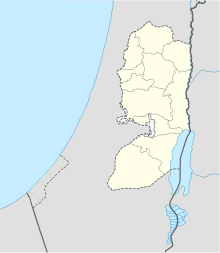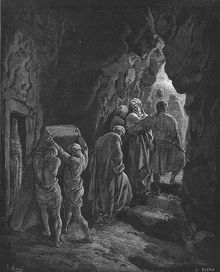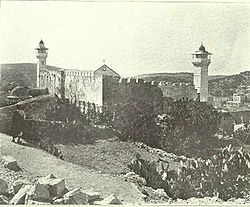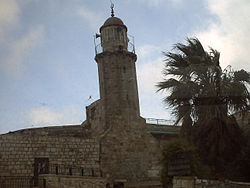- Cave of the Patriarchs
-
Cave of the Patriarchs 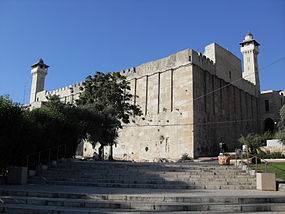
Southern view of the enclosure Location Hebron Region West Bank Coordinates 31°31′29″N 35°06′39″E / 31.524744°N 35.110726°E Type Islamic mosque
tombThe Cave of the Patriarchs or the Cave of Machpelah (Hebrew: מערת המכפלה,
 Me'arat ha-Machpela (help·info), trans. "cave of the double tombs"), is known by Muslims as the Sanctuary of Abraham or Ibrahimi Mosque (Arabic: الحرم الإبراهيمي,
Me'arat ha-Machpela (help·info), trans. "cave of the double tombs"), is known by Muslims as the Sanctuary of Abraham or Ibrahimi Mosque (Arabic: الحرم الإبراهيمي,  Al-Haram Al-Ibrahimi (help·info)).
Al-Haram Al-Ibrahimi (help·info)).Situated beneath a large rectangular Herodian era structure, the series of subterranean chambers is located in the heart of Hebron's old city in the Judean hills. The shrine is the world's most ancient Jewish site and the second holiest place for the Jewish people, after Temple Mount in Jerusalem. Some believe the cave and adjoining field were purchased by Abraham some 3700 years ago. Abraham, Isaac, Jacob, Sarah, Rebecca, and Leah, considered the Patriarchs and Matriarchs of the Jewish people, are all believed to be buried there. The only matriarch missing is Rachel, who was buried near Bethlehem where she died in childbirth. [1] The Hebrew name possibly refers to the physical layout of the original two chambers. Jacob "digged" (Genesis 50:5) further in, to make a third chamber for Leah and himself.
The Arabic name of the complex reflects the prominence given to Abraham, revered by Muslims as a Quranic prophet and patriarch through Ishmael. Outside biblical and Quranic sources there are a number of legends and traditions associated with the cave, some of which are addressed below.
Contents
Biblical origin
According to the Book of Genesis 23:1-20, Sarah, the wife of Abraham, "died in Kirjath-arba; the same is Hebron in the land of Canaan". Sadly, Abraham was tending to business elsewhere[2] when she died, at the age of 127 years,[3] and he "came to mourn for Sarah, and to weep for her." (Genesis 23:2) After awhile, he stood up and spoke to the "sons of Heth" and requested they give him a possession as a "burying place", and they offered him his "choice" of their sepulchres. And then in verse 7 he again "stood up" to speak to them. Abraham then requested that Ephron the Hittite, the son of Zohar, give him the cave of Machpelah, in the end of his field, "for as much money as it is worth". (verse 9) After Ephron confirmed that he would give the cave, in verse 11, Abraham further requested that he give him the field for money, in verse 13. Ephron agreed and named a price.
Genesis 23:16 ¶ And Abraham hearkened unto Ephron; and Abraham weighed to Ephron the silver, which he had named in the audience of the sons of Heth, four hundred shekels of silver, current money with the merchant. [17] And the field of Ephron, which was in Machpelah, which was before Mamre, the field, and the cave which was therein, and all the trees that were in the field, that were in all the borders round about, were made sure [18] Unto Abraham for a possession in the presence of the children of Heth, before all that went in at the gate of his city.
The burial of Sarah is the first account of a burial[4] in the Bible, and this is the first commercial transaction mentioned. The next burial in the cave of Machpelah is that of Abraham, who lived "an hundred threescore and fifteen years" - one hundred years unto the birth of Isaac, and threescore (60) more years unto the birth of Esau and Jacob. (Genesis 25:26) The title deed to the cave was part of the property of Abraham that passed to his son Isaac in Genesis 25:5-6.
Genesis 25:9 And his sons Isaac and Ishmael buried him in the cave of Machpelah, in the field of Ephron the son of Zohar the Hittite, which is before Mamre; [10] The field which Abraham purchased of the sons of Heth: there was Abraham buried, and Sarah his wife.
Isaac was 180 years old when he died, and his sons Esau and Jacob buried him. (Genesis 35:28-29) As noted above, Isaac was 60 when they were born, so they were 120 years old here, which is 10 years before Jacob, at the age of 130, stood before Pharoah in Genesis 47:9. Jacob died later at the age of 147 years. (Genesis 47:28) There is no mention of how or when Isaac's wife Rebekah died, nor of Jacob's wife Leah, but they are included in the list of those that had been buried in Machpelah in Jacob's final words to the children of Israel:
Genesis 49:29 And he charged them, and said unto them, I am to be gathered unto my people: bury me with my fathers in the cave that is in the field of Ephron the Hittite, [30] In the cave that is in the field of Machpelah, which is before Mamre, in the land of Canaan, which Abraham bought with the field of Ephron the Hittite for a possession of a buryingplace. [31] There they buried Abraham and Sarah his wife; there they buried Isaac and Rebekah his wife; and there I buried Leah. [32] The purchase of the field and of the cave that is therein was from the children of Heth. [33] And when Jacob had made an end of commanding his sons, he gathered up his feet into the bed, and yielded up the ghost, and was gathered unto his people.
In the final chapter of Genesis, Joseph had his physicians embalm his father, before they removed him from Egypt to be buried in the cave of the field of Machpelah. (Genesis 50:1-14) When Joseph died in the last verse, he was also embalmed. He was buried much later in Shechem (Joshua 24:32) after the children of Israel came into the promised land.
History
Herod the Great built a large, rectangular enclosure over the caves, the only fully surviving Herodian structure. Herod's building, with 6-foot-thick stone walls made from stones that were at least 3 feet tall and sometimes reach a length of 24 feet, did not have a roof. Archæologists are not certain where the original entrance to the enclosure was located, or even if there was one.[5]
Until the era of the Byzantine Empire, the interior of the enclosure remained exposed to the sky. Under Byzantine rule, a simple basilica was constructed at the southeastern end and the enclosure was roofed everywhere except at the centre. In 614, the Persians conquered the area and destroyed the castle, leaving only ruins; but in 637, the area came under the control of the Muslims and the building was reconstructed as a roofed mosque.
During the 10th century, an entrance was pierced through the north-eastern wall, some way above the external ground level, and steps from the north and from the east were built up to it (one set of steps for entering, the other for leaving).[5] A building known as the kalah (castle) was also constructed near the middle of the southwestern side. Its purpose is unknown but one historic account claims that it marked the spot where Joseph was buried (see Joseph's tomb), the area having been excavated by a Muslim caliph, under the influence of a local tradition regarding Joseph's tomb.[5] Some archaeologists believe that the original entrance to Herod's structure was in the location of the kalah and that the northeastern entrance was created so that the kalah could be built by the former entrance.[5]
In 1100, after the area was captured by the Crusaders, the enclosure once again became a church and Muslims were no longer permitted to enter. During this period, the area was given a new gabled roof, clerestory windows and vaulting. In 1188, however, Saladin conquered the area, reconverting the enclosure to a mosque but allowing Christians to continue worshipping there. Saladin also added a minaret at each corner — two of which still survive — and the minbar.[5]
No one but a Mahommedan is allowed to visit this place, which is a great privation for the Jews.
A. Howard, 1858.[6]Benjamin of Tudela relates: "At Hebron there is a large place of worship called 'St. Abraham,' which was previously a Jewish synagogue. The natives erected there six sepulchers, which they tell foreigners are those of the Patriarchs and their wives, demanding money as a condition of seeing them. If a Jew gives an additional fee to the keeper of the cave, an iron door which dates from the time of our forefathers opens, and the visitor descends with a lighted candle. He crosses two empty caves, and in the third sees six tombs, on which the names of the three Patriarchs and their wives are inscribed in Hebrew characters. The cave is filled with barrels containing bones of people, which are taken there as to a sacred place. At the end of the field of the Machpelah stands Abraham's house with a spring in front of it".[7] Samuel ben Samson visited the cave in 1210; he says that the visitor must descend by twenty-four steps in a passageway so narrow that the rock touches him on either hand.[8]
In the late 14th century, under the Mamluks, two additional entrances were pierced into the western end of the south western side and the kalah was extended upwards to the level of the rest of the enclosure. A cenotaph in memory of Joseph was created in the upper level of the kalah so that visitors to the enclosure would not need to leave and travel round the outside just to pay respects.[5] The Mamluks also built the northwestern staircase and the six cenotaphs (for Isaac, Rebecca, Jacob, Leah, Abraham, and Sarah, respectively), distributed evenly throughout the enclosure. The Mamluks forbade Jews from entering the site, only allowing them as close as the fifth step on a staircase at the southeast, but after some time this was increased to the seventh step.
Israeli control
Until 1929 Jews were forbidden from entering the site, and were not allowed past the seventh step leading up to the tombs. Following the 1929 Hebron massacre, access by Jews was severely restricted by British Mandate authorities. After Israeli Statehood in 1948 and occupation of the West Bank and East Jerusalem by Jordan no Jews were allowed anywhere in the West Bank. Following the Israeli victory over the Jordanians in the Six Day War, the area came back under Jewish control for the first time in 2,000 years and the 1,400-year-long restriction limiting Jews to the seventh step was lifted. Israelis immediately began settling in the city after the Six Day War. The first subsequent Jewish wedding ceremony took place on 7 August 1968.[9]
In 1968, a special arrangement was made to accommodate Jewish services on the Jewish New Year and Day of Atonement. This led to a hand-grenade being thrown on the stairway leading to the tomb on October 9 in which 47 Israelis were injured, 8 seriously.[10][11] On November 4, a large explosion went off near the gate to the compound and 6 people, Jews and Arabs, were wounded.[11] On Yom Kippur eve, October 3, 1976, an Arab mob destroyed several Torah scrolls and prayer books at the tomb.[12] In May 1980, an attack on Jewish worshippers returning from prayers at the tomb left 6 dead and 17 wounded.[13]
Tensions would later increase as the Israeli government signed the Oslo Accords in September 1993, which gave limited autonomy to the PLO in the West Bank city of Jericho and the Gaza Strip. The city of Hebron and the rest of the major Palestinian population centers in the West Bank were not included in the initial agreement.[14] A shooting spree committed by an Israeli-American settler in February 1994, left 29 Palestinian Muslims dead and scores injured. The resulting riots resulted in a further 35 deaths.
The increased sensitivity of the site meant that in 1996 the Wye River Accords, part of the Arab-Israeli peace process, included a temporary status agreement for the site restricting access for both Jews and Muslims. As part of this agreement, the waqf controls 81% of the building. This includes the whole of the southeastern section, which lies above the only known entrance to the caves and possibly over the entirety of the caves themselves. In consequence, Jews are not permitted to visit the Cenotaphs of Isaac or Rebecca, which lie entirely within the southeastern section, except for 10 days a year which hold special significance in Judaism. One of these days is the Shabbat Chayei Sarah, when the Torah portion concerning the deaths of Abraham and Sarah and the purchase by Abraham of the land in which the caves are situated, is read.
The Israeli authorities do not allow Jewish religious authorities the right to maintain the site and only allow the waqf to do so. Tourists are permitted to enter the site. Security at the site has increased since the Intifada; the Israel Defense Forces surround the site with soldiers and control access to the shrines.
On February 21, 2010, Israel announced that it would include the site in a national heritage site protection and rehabilitation plan. The announcement sparked protests from the UN, Arab governments and the United States.[15][16] A subsequent UNESCO vote in October aimed to affirm that the "al-Haram al-Ibrahimi/Tomb of the Patriarchs in al-Khalil/Hebron" was "an integral part of the occupied Palestinian Territories."[17]
Structure
The rectangular stone enclosure lies on a northwest-southeast axis, and is divided into two sections by a wall running between the northwestern three fifths, and the southeastern two fifths. The northwestern section is roofed on three sides, the central area and north eastern side being open to the sky; the southeastern section is fully roofed, the roof being supported by four columns evenly distributed through the section.
In the northwestern section are four cenotaphs, each housed in a separate octagonal room, those dedicated to Jacob and Leah being on the northwest, and those to Abraham and Sarah on the southeast. A corridor runs between the cenotaphs on the northwest, and another between those on the southeast. A third corridor runs the length of the southwestern side, through which access to the cenotaphs, and to the southeastern section, can be gained. An entrance to the enclosure exists on the southwestern side, entering this third corridor; a mosque outside this entrance must be passed through to gain access.
At the center of the northeastern side, there is another entrance, which enters the roofed area on the southeastern side of the northwestern section, and through which access can also be gained to the southeastern (fully roofed) section. This entrance is approached on the outside by a corridor which leads from a long staircase running most of the length of the northwestern side.[18] The southeastern section, which functions primarily as a mosque, contains two cenotaphs, symmetrically placed, near the center, dedicated to Isaac and Rebecca. Between them, in the southeastern wall, is a mihrab. The cenotaphs have a distinctive red and white horizontal striped pattern to their stonework, but are usually covered by decorative cloth.
Under the present arrangements, Jews are restricted to entering by the southwestern side, and limited to the southwestern corridor and the corridors which run between the cenotaphs, while Muslims may only enter by the northeastern side, and are restricted to the remainder of the enclosure.
The caves
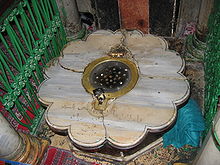 The more visible known entrance to the caves.[19]
The more visible known entrance to the caves.[19]
The caves under the enclosure are not themselves generally accessible; the waqf have historically prevented access to the actual tombs out of respect for the dead. Only two entrances are known to exist, the most visible of which is located to the immediate southeast of Abraham's cenotaph on the inside of the southeastern section. This entrance is a narrow shaft covered by a decorative grate, which itself is covered by an elaborate dome. The other entrance is located to the southeast, near the mihrab, and is sealed by a large stone, and usually covered by prayer mats; this is very close to the location of the seventh step on the outside of the enclosure, beyond which the Mamelukes forbade Jews from approaching.
When the enclosure was controlled by crusaders, access was occasionally possible. One account, by Rabbi Benjamin of Tudela dating from 1163 CE, states that after passing through an iron door, and descending, the caves would be encountered. According to Benjamin of Tudela, there was a sequence of three caves, the first two of which were empty; in the third cave were six tombs, arranged to be opposite to one another.[20]
These caves had only been rediscovered in 1119 CE by a monk named Arnoul, who had noticed a draught in the area near where the mihrab is at present, and had removed the flagstones and found a room lined with Herodian masonry. Arnoul, still searching for the source of the draught, hammered on the cave walls until he heard a hollow sound, pulled down the masonry in that area, and discovered a narrow passage. The narrow passage, which subsequently became known as the serdab (Arabic for passage), was similarly lined with masonry, but partly blocked up. Having unblocked the passage, Arnoul discovered a large round room with plastered walls. In the floor of the room, he found a square stone slightly different from the others and, upon removing it, found the first of the caves. The caves were filled with dust. After removing the dust, Arnoul found bones; believing the bones to be those of the Biblical Patriarchs, Arnoul washed them in wine and stacked them neatly. Arnoul carved inscriptions into the caves describing whose bones he believed them to be.[5]
This passage to the caves was sealed at some time after Saladin had recaptured the area, though the roof of the circular room was pierced, and a decorative grate was placed over it. In 1967, after the Six Day War, the area fell into the hands of the Israel Defence Forces, and Moshe Dayan, the Defence Minister, and an amateur archaeologist, attempted to regain access to the tombs. Dayan, not knowing about the serdab entrance, started investigating the shaft visible beyond the decorative grate and came up with the idea of sending someone thin enough through the shaft and down into the chamber below. Dayan eventually found a slim 12 year old girl named Michal and sent her into the chamber with a camera.[21][22]
Michal explored the round chamber, but failed to spot the stone in the floor that led to the caves. Michal did, however, explore the passage and find steps leading up to the surface, though the exit was blocked by a large stone (this is the entrance near the mihrab).[5] According to the report of her findings, which Michal gave to Dayan after having been lifted back through the shaft, there are 16 steps leading down into the passage, which is 1 cubit wide, 17.37 metres (57.0 ft) and 1 metre (3 ft 3 in) high. In the round chamber, which is 12 metres (39 ft) below the entrance to the shaft, there are three stone slabs, the middle one of which contains a partial inscription of Sura 2, verse 255, from the Qur'an, the famous Ayatul Kursi, Verse of the Throne.[5]
In 1981 Seev Jevin, the former director of the Israel Antiquities Authority, entered the passage after a group of Jewish settlers from Hebron had entered the chamber via the entrance near the mihrab and discovered the square stone in the round chamber that concealed the cave entrance. The reports state that after entering the first cave, which Jevin regarded as empty, he found a passage leading to a second oval chamber, smaller than the first, which contained shards of pottery and a wine jug.[23]
Legends and Traditions
Judaism[24] and Islam accepted the Jewish tradition that entombed within are the Biblical and Qur'anic patriarchs (Abraham, Isaac, and Jacob) as well as three matriarchs (Sarah, Rebecca, and Leah).[25][citation needed]
According to the Midrash and other traditions, the Cave of the Patriarchs also contains the head of Esau,[26] The Talmud (Sotah 13a) places Esau's head at the Cave of the Patriarchs, but does not indicate whether it is buried there. The story is told in the context of Esau having come to wage war against the Israelites. Accordingly, Esau tried to prevent Jacob's burial at the Cave of the Patriarchs. Incensed by this, one of Jacob's grandsons took a club and struck Esau on the head so that his eyes fell out and rolled to the feet of Jacob. Jacob opened his eyes and laughed, and as it is written, "The righteous shall rejoice when he sees the vengeance; he shall wash his feet in the blood of the wicked." Rabbinical reflection on why Esau's body is not buried with Esau's head is captured by R. Hayyim of Volozhyn. Evil power will be destroyed in the future. "This is the meaning of the future destruction of the evil power as stated by our sages. Because only his head will remain in the sacred place and will be separate so that it does not roll down into the evil...because through repentance his acts of sinning committed below will be cancelled and no condemnation of them will remain above."[27]
Other Jewish sources indicate that Esau was not to be buried in the Cave of the Patriarchs. According to a commentary on the "Book of Exodus", Jacob gave all his possessions to acquire a tomb in the Cave of the Patriarchs. He put a large pile of gold and silver before Esau and asked, “My brother, do you prefer your portion of this cave, or all this gold and silver?”[28] Esau's selling to Jacob his right to be buried in the Cave of the Patriarchs is also recorded in Sefer HaYashar.[29]
According to some Islamic sources it is also the tomb of Joseph. Though the Bible has Joseph buried in Shechem (the present-day Palestinian city of Nablus), Jewish aggadic tradition conserved the idea that he wished to be interred at Hebron, and the Islamic version may reflect this.[30] The Jewish apocryphal book, The Testaments of the Twelve Patriarchs, also states that this is the burial place of Jacob's twelve sons.[31] The New Testament in Acts 7:16 indicates that the twelve patriarchs were buried in Sychem/Shechem.
Judaism
In Judaism, the Tomb of the Patriarchs is the second most sacred site in the world, after the Temple Mount.[32][33] The Book of Genesis relates that Abraham specifically purchased the land as a burial plot from Ephron the Hittite, making it one of two purchases by Abraham of real estate in the Land of Canaan, the Promised Land. According to Genesis, three biblical couples are buried there:
- Abraham and Sarah (Genesis 23:1-20; Genesis 49:31)
- Isaac and Rebekah (Genesis 35:29; Genesis 49:31)
- Jacob and Leah (Genesis 49:28-33; Genesis 50:4-5; Genesis 50:12-13)
Jacob's other wife, Rachel, was buried "in the way to Ephrath, which is Bethlehem." (Genesis 35:19-20)
There is a Jewish tradition, that besides the three biblical couples mentioned above, that Adam and Eve were buried there also. (Zohar, Ruth 96) Certain Kabbalah texts also add that Moses and Zipporah are buried in the cave.[1]
An early Jewish text, the Genesis Rabba, states that this site is one of three that enemies of Judaism cannot taunt the Jews by saying "you have stolen them," as it was purchased "for its full price" by Abraham.[34]
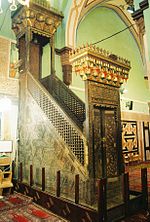 The minbar at the Ibrahimi Mosque
The minbar at the Ibrahimi Mosque
According to the Midrash, the Patriarchs were buried in the cave because the cave is the threshold to the Garden of Eden. The Patriarchs are said not to be dead but "sleeping". They rise to beg mercy for their children throughout the generations. According to the Zohar,[35] this tomb is the gateway through which souls enter into Gan Eden—heaven.
There is a Jewish tradition that praying at the Tomb will bring good fortune in finding a proper spouse.[citation needed] There are Hebrew prayers of supplication for marriage on the walls of the Sarah cenotaph.
The Lubavitcher Rebbe declared that the Tomb of the Patriarchs ought to be in exclusively Jewish control, because 1) most Arabs today are not descended from Ishmael; 2) Ishmael, although the biological son of Abraham did not inherit from him, as Ishmael was the progeny of a maidservant (Hagar), and such progeny does not inherit.[36]
Islam
The enclosure is known to Muslims as the Ibrahimi Mosque, as Abraham is a revered prophet of Islam who, according to the Qur'an, built the Kaaba in Mecca with his son Ishmael. After the conquest of the city by Umar, the Herodian enclosure was converted into a mosque and placed under the control of a waqf. The waqf continues to control and maintain most of the site.
See also
- Burial places of founders of world religions
- Tomb of the Matriarchs
- List of National Heritage Sites of Israel
Citations and notes
- ^ {{Source |url=http://www.jewishvirtuallibrary.org/jsource/Judaism/machpelah.html |title=Cave of Machpelah |publisher=Jewish Virtual Library
- ^ Acts 7:16 see Age of Abraham
- ^ Sarah is the only woman in the old testament whose full age is given.
- ^ Easton Bible Dictionary "burial"
- ^ a b c d e f g h i Biblical Archaeology Review, Patriarchal Burial Site Explored for First Time in 700 Years, May/June 1985
- ^ General Convention of the New Jerusalem in the United States of America; Massachusetts New-Church Union (1858). New Jerusalem magazine. A. Howard. p. 119. http://books.google.com/books?id=33oUAAAAYAAJ&pg=PA119. Retrieved 14 October 2010.
- ^ "Itinerary," ed. Asher, pp. 40-42, Hebr.
- ^ "Pal. Explor. Fund," Quarterly Statement, 1882, p. 212).
- ^ Hoberman, Haggai (2008) (in Hebrew). Keneged Kol HaSikuim [Against All Odds] (1st ed.). Sifriat Netzaim.
- ^ Esther Rosalind Cohen (1985). Human rights in the Israeli-occupied territories, 1967-1982. Manchester University Press ND. p. 215. ISBN 9780719017261. http://books.google.com/books?id=awq8AAAAIAAJ&pg=PA215. Retrieved 14 October 2010.
- ^ a b Dishon (January 1973). Middle East Record 1968. John Wiley and Sons. p. 383. ISBN 9780470216118. http://books.google.com/books?id=wwgXS-iquj0C&pg=PA383. Retrieved 14 October 2010.
- ^ Mati Alon (2003). The Unavoidable Surgery. Trafford Publishing. p. 160. ISBN 9781412010047. http://books.google.com/books?id=ZPPaQYSHvP0C&pg=PA160. Retrieved 14 October 2010.
- ^ Ervin Birnbaum (1990). In the shadow of the struggle. Gefen Publishing House Ltd. p. 286. ISBN 9789652290373. http://books.google.com/books?id=GB8uPatYT6kC&pg=PA286. Retrieved 14 October 2010.
- ^ William Quandt, Peace Process3rd edition, (Brookings Institution and University of California Press, 2005): 321-329.
- ^ "Israel to include West Bank shrines in heritage plan". Reuters. 2010-02-22. http://www.reuters.com/article/idUSTRE61K1QL20100221.
- ^ "US slams Israel over designating heritage sites". Haaretz. 2010-02-24. http://www.haaretz.com/news/u-s-slams-israel-over-designating-heritage-sites-1.263737.
- ^ "Executive Board adopts five decisions concerning UNESCO’s work in the occupied Palestinian and Arab Territories". unesco.org. 2010-10-21. http://www.unesco.org/new/en/media-services/single-view/news/executive_board_adopts_five_decisions_concerning_unescos_work_in_the_occupied_palestinian_and_arab_territories/.
- ^ "a floorplan". http://members.bib-arch.org/nph-proxy.pl/000000A/http/www.basarchive.org/bswb_graphics/BSBA/11/03/BSBA110303200.jpg.
- ^ "A wider image of the same side.". http://members.bib-arch.org/nph-proxy.pl/000000A/http/www.basarchive.org/bswb.
- ^ International Standard Bible Encyclopedia
- ^ "photograph of Michal descending through the grated shaft". http://www.basarchive.org/bswb_graphics/BSBA/11/03/BSBA110304200.jpg.
- ^ Joseph Free and Howard F. Vos (1992) Archaeology and Bible History Zondervan, ISBN 0310479614 p 62
- ^ Der Spiegel, 52/2008 Title Story: Abraham, page 104
- ^ These are some of the biblical Jewish sources: "Genesis"23:9 (Sarah),25:9(Abraham),35:29(Isaac)Gen:49:31(Abraham,Sarah,Isaac,Rebecca,Leah),Gen:50:13)
- ^ Although this Islamic opinion does not seem to be recorded in the Qur'an, it is to be found in Ibn Kathir's 14th century Qur'anic commentary Stories of the Prophet
- ^ The Sefer Ha-yashar has the head buried ‘in that place where the battle had been in Hebron’ (Kiryat Arba, before the Cave of Machpelah) Mordecai Manuel Noah (tr.) Book of Jasher, M.M. Noah & A.S. Gould, 1840, chapters 56,50: 57:4, pp.184-5
- ^ R. Chaim ben Yitzhak of Volozhyn, Masechet Avot-Ruach Chaim.
- ^ "Shemot Rabbah"31:17
- ^ Sefer Hayashar Chapter 27 p.77b
- ^ Shalom Goldman, 'The Wiles of Women/the Wiles of Men: Joseph and Potiphar's Wife in Ancient Near Eastern, Jewish, and Islamic Folklore,SUNY Press, 1995 pp.126-7
- ^ http://www.earlychristianwritings.com/text/patriarchs-charles.html
- ^ http://frontpagemag.org/Articles/ReadArticle.asp?ID=8095
- ^ http://onejerusalem.org/ItemDetail.asp?Language=English&ItemID=1509
- ^ Genesis Rabba 79.7: "And he bought the parcel of ground, where he had spread his tent...for a hundred pieces of money." Rav Yudan son of Shimon said: ‘This is one of the three places where the non-Jews cannot deceive the Jewish People by saying that they stole it from them, and these are the places: Ma’arat HaMachpela, the Temple and Joseph's burial place. Ma’arat HaMachpela because it is written: ‘And Abraham hearkened unto Ephron; and Abraham weighed to Ephron the silver,’ (Genesis, 23:16); the Temple because it is written: ‘So David gave to Ornan for the place,’ (I Chronicles, 21:26); and Joseph's burial place because it is written: ‘And he bought the parcel of ground...Jacob bought Shechem.’ (Genesis, 33:19)." See also: Kook, Abraham Isaac, Moadei Hare'iya, pp. 413–415.
- ^ Zohar 127a
- ^ See Exclusively Jewish ownership of the Tomb of the Patriarchs.
External links
- Official Website (Israeli)
- The Cave of Machpelah Tomb of the Patriarch Jewish Virtual Library
- Tombs of the Patriarchs Article and Photos Sacred Destinations
- Demands for Equal Rights for the Jewish People at Ma'arat HaMachpela Hebron.org.il
- Aerial Photograph Google Maps
 "Machpelah". Catholic Encyclopedia. New York: Robert Appleton Company. 1913.
"Machpelah". Catholic Encyclopedia. New York: Robert Appleton Company. 1913.- Bible Land Library
- Photos and Diagram of Underground at Caves of Machpela
Mosques in Israel and the Palestinian territories Israel al-Bahr Mosque • Hassan Bek Mosque • Jezzar Pasha Mosque • Mahmood Mosque • Mahmoudiya Mosque • Makam al-Nabi Sain Mosque • al-Muallaq Mosque • Sidna Ali Mosque • White Mosque (Nazareth) • White Mosque (Ramla)

East Jerusalem West Bank Great Mosque of Nablus • al-Hamadiyya Mosque • Jamal Abdel Nasser Mosque • al-Khadra Mosque • Ibrahimi Mosque • Nabi Yahya Mosque • an-Nasr Mosque • Mosque of Omar • Sultan Ibrahim Ibn Adham MosqueGaza Strip Great Mosque of Gaza • Ibn Marwan Mosque • Ibn Uthman Mosque • Sayed al-Hashim Mosque • Umm al-Naser Mosque • Welayat MosqueCategories: Israel, Palestine – Islam in Israel and the Palestinian territories – Mosques by countryReligious Sites in the Palestinian Authority Ancient synagogue (Gaza) · Burqin Church · Church of the Nativity · Mosque of Omar (Bethlehem) · Cave of the Patriarchs† · Joseph's Tomb · Jacob's Well · Al-Khadra Mosque · Great Mosque of Nablus · An-Nasr Mosque · Tomb of Lazarus (al-Eizariya) · Tomb of Joshua · Great Mosque of Gaza · Monastery of the Temptation · Shalom Al Yisrael Synagogue · Mount Gerizim · Mount Ebal
† Although the Cave of the Patriarchs rests in Area A of the West Bank, access to the site is controlled by Israel.Holy sites in Judaism Holiest sites Four Holy Cities Land Tombs of biblical figures Categories:- Israel National Heritage Site
- Caves of the West Bank
- Conversion of non-Christian places of worship into churches
- Conversion of non-Muslim places of worship into mosques
- Hebrew Bible places
- Hebron
- Arabic architecture
- Islamic holy places
- Mosques in the West Bank
- Torah places
- Ziyarat
- Jewish mausoleums
- Abraham
- Jacob
- Isaac
- Tombs of biblical people
- Jewish pilgrimage sites
- Book of Genesis
Wikimedia Foundation. 2010.

